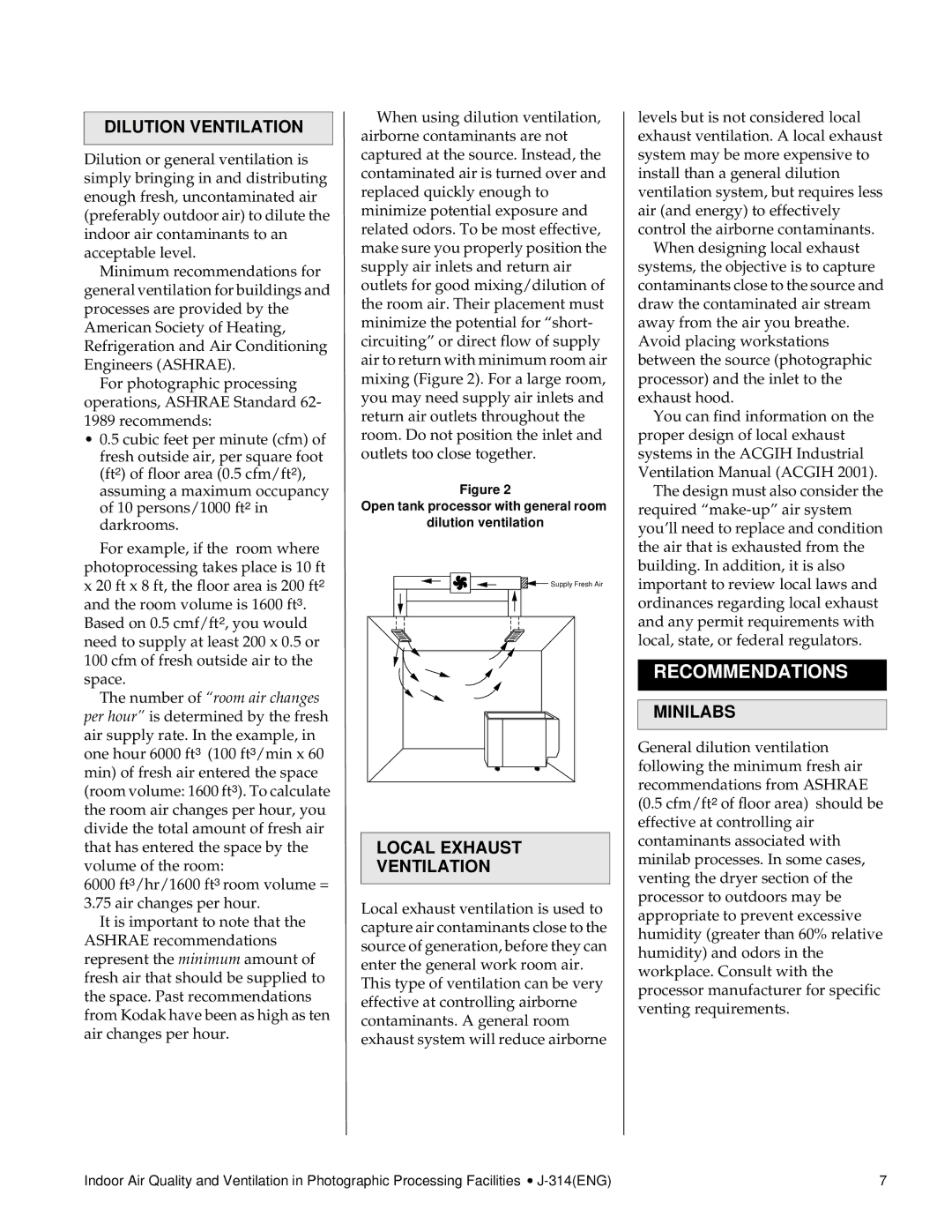
DILUTION VENTILATION
Dilution or general ventilation is simply bringing in and distributing enough fresh, uncontaminated air (preferably outdoor air) to dilute the indoor air contaminants to an acceptable level.
Minimum recommendations for general ventilation for buildings and processes are provided by the American Society of Heating, Refrigeration and Air Conditioning Engineers (ASHRAE).
For photographic processing operations, ASHRAE Standard 62-
1989 recommends:
•0.5 cubic feet per minute (cfm) of fresh outside air, per square foot (ft2) of floor area (0.5 cfm/ft2), assuming a maximum occupancy of 10 persons/1000 ft2 in darkrooms.
For example, if the room where photoprocessing takes place is 10 ft x 20 ft x 8 ft, the floor area is 200 ft2 and the room volume is 1600 ft3.
Based on 0.5 cmf/ft2, you would need to supply at least 200 x 0.5 or 100 cfm of fresh outside air to the space.
The number of “room air changes per hour” is determined by the fresh air supply rate. In the example, in one hour 6000 ft3 (100 ft3/min x 60 min) of fresh air entered the space (room volume: 1600 ft3). To calculate the room air changes per hour, you divide the total amount of fresh air that has entered the space by the volume of the room:
6000 ft3/hr/1600 ft3 room volume =
3.75 air changes per hour.
It is important to note that the ASHRAE recommendations represent the minimum amount of fresh air that should be supplied to the space. Past recommendations from Kodak have been as high as ten air changes per hour.
When using dilution ventilation, airborne contaminants are not captured at the source. Instead, the contaminated air is turned over and replaced quickly enough to minimize potential exposure and related odors. To be most effective, make sure you properly position the supply air inlets and return air outlets for good mixing/dilution of the room air. Their placement must minimize the potential for “short- circuiting” or direct flow of supply air to return with minimum room air mixing (Figure 2). For a large room, you may need supply air inlets and return air outlets throughout the room. Do not position the inlet and outlets too close together.
Figure 2
Open tank processor with general room
dilution ventilation
![]() Supply Fresh Air
Supply Fresh Air
LOCAL EXHAUST
VENTILATION
Local exhaust ventilation is used to capture air contaminants close to the source of generation, before they can enter the general work room air.
This type of ventilation can be very effective at controlling airborne contaminants. A general room exhaust system will reduce airborne
levels but is not considered local exhaust ventilation. A local exhaust system may be more expensive to install than a general dilution ventilation system, but requires less air (and energy) to effectively control the airborne contaminants.
When designing local exhaust
systems, the objective is to capture contaminants close to the source and draw the contaminated air stream away from the air you breathe. Avoid placing workstations between the source (photographic processor) and the inlet to the exhaust hood.
You can find information on the proper design of local exhaust systems in the ACGIH Industrial Ventilation Manual (ACGIH 2001).
The design must also consider the required
RECOMMENDATIONS
MINILABS
General dilution ventilation following the minimum fresh air recommendations from ASHRAE (0.5 cfm/ft2 of floor area) should be effective at controlling air contaminants associated with minilab processes. In some cases, venting the dryer section of the processor to outdoors may be appropriate to prevent excessive humidity (greater than 60% relative humidity) and odors in the workplace. Consult with the processor manufacturer for specific venting requirements.
Indoor Air Quality and Ventilation in Photographic Processing Facilities • | 7 |
